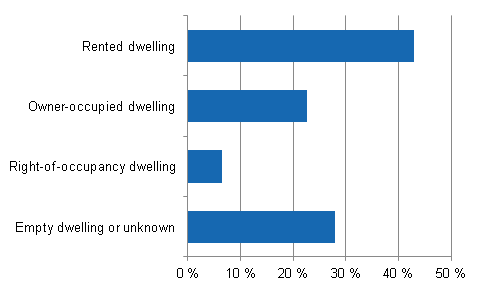1. Dwelling stock 2013
2.9 million dwellings
At the end of 2013, there were 2,906,000 dwellings in Finland, of which 306,000 were without permanent occupants. The dwelling stock went up by 40,000 dwellings from the previous year. From 1990, the building stock has increased by 696,000 dwellings, or by about 30,000 dwellings per year. Compared to 1990, 127,000 more dwellings were without permanent occupants. The growth in the building stock has been slowing down from the preceding decade. Most dwellings have been built in the 1970s- and 1980`s. Residential building construction has centred in urban municipalities. In all, 76 per cent of the dwellings completed in the 1995- to 2013 period are located in urban areas.
44 per cent of all dwellings are in blocks of flats
As recently as 1990, the numbers of dwellings in detached houses and blocks of flats were still almost equal. At that time, dwellings in blocks of flats numbered 939,000 and those in detached houses only 4,000 fewer. The share of dwellings in blocks of flats grew over the 1990s, however. At the end of 2013, 44 per cent of all dwellings were in blocks of flats, i.e. 1,290,000 which is 125,000 more dwellings in blocks of flats than in detached houses. The number of terraced houses has grown over tenfold since 1970. In 1970 they numbered only 30,000 but the figure had gone up to 396,000 by the end of 2013.
Average floor area of dwellings 80 square metres
In 2013 the average floor area of a dwelling was 79.9 square metres. The average floor area of the dwelling stock has grown by about 20 square metres since 1970. The average floor area of a one-room unit was 34 square metres, that of a two-room unit 55 square metres, and that of a three-room unit and a kitchen 79 square metres. Despite the growth in the average size of dwellings, there were about 118,000 dwellings of under 30 square metres. In contrast, only 27 per cent of dwellings have a floor area of over 100 square metres. There are 423,000 one-room units with a kitchen or kitchenette, i.e. 15 per cent of the dwelling stock. The most common type of dwelling is a two-room unit. There are 869,000 two-room units with a kitchen or kitchenette, i.e. 30 per cent of the dwelling stock.
Table 1. Floor area per dwelling (m2) by type of building in 1970–2013
| Year | Type of building | ||||
| Total | Detached houses | Attached houses | Blocks of flats | Other buildings | |
| 1970 | 60,0 | 66,0 | 73,0 | 51,0 | 54,0 |
| 1980 | 69,3 | 83,6 | 71,7 | 54,8 | 55,5 |
| 1990 | 74,4 | 95,3 | 70,2 | 55,8 | 59,7 |
| 2000 | 76,5 | 101,9 | 70,0 | 56,1 | 59,8 |
| 2010 | 79,5 | 108,4 | 71,2 | 56,5 | 60,7 |
| 2013 | 79,9 | 109,9 | 71,3 | 56,5 | 60,6 |
The average floor area of an owner-occupied dwelling was 96 square metres and most of them are in detached houses. The average floor area of a rental dwelling was 53 square metres and most of them are in blocks of flats. In the dwelling stock statistics the tenure status is mainly defined for permanently occupied dwellings. The tenure status is also defined for a dwelling not permanently occupied when a dwelling is located in a rented dwelling subsidised by the state or a dwelling is temporarily occupied. Of all dwellings, the number of rented dwellings was around 840,000 at the end of 2013 and 796,000 of them were permanently occupied dwellings. The number of rented dwellings has grown by 294,000 since 1990.
43 per cent of new dwellings in blocks of flats were rented in 2013
According to Statistics Finland's data, around 16,000 new dwellings in blocks of flats were completed in 2013, of which 43 per cent were rented dwellings at the end of 2013. Nearly six per cent of new dwellings in blocks of flats were right-of-occupancy dwellings and the rest of the dwellings were owner-occupied dwellings (23%) or still unoccupied (28%). The number of unoccupied dwellings is due to the fact that the tenure status of dwellings is mainly based on notices of removal and people move into newly completed dwellings in blocks of flats partly during the following year.
Figure 1. Flats completed in 2013 by tenure status at the end of the year, %

New blocks of flats completed in 2013 had over 6,800 rented dwellings. Around 2,600 of them were interest-subsidised rented dwellings supported by the state. Government-subsidised rented dwellings do not here include rented dwellings with short-term interest subsidy loans, or of the so-called interim model.
In 2013, a total of 32,000 dwellings were completed, of which 11,000 were in detached houses, 4,000 in terraced houses and 16,000 in blocks of flats. Approximately 8,600 new dwellings were completed in Greater Helsinki, 6,700 of them in blocks of flats. Forty-one per cent of new dwellings in blocks of flats were rented dwellings at the end of 2013.
Source: Dwellings and Housing Conditions, Statistics Finland
Inquiries: Topias Pyykkönen 029 551 2628, Marja Hermiö 029 551 3211, Arja Tiihonen 029 551 3272, asuminen@stat.fi
Director in charge: Riitta Harala
Updated 16.10.2014
Official Statistics of Finland (OSF):
Dwellings and housing conditions [e-publication].
ISSN=1798-6761. Overview 2013,
1. Dwelling stock 2013
. Helsinki: Statistics Finland [referred: 27.12.2025].
Access method: http://stat.fi/til/asas/2013/01/asas_2013_01_2014-10-16_kat_001_en.html

